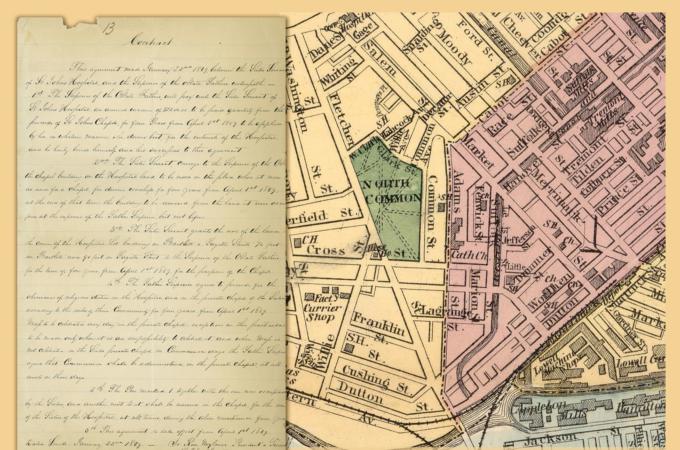The establishment of St. John Hospital in Lowell
In 1863, a small infirmary opened on Adams Street in Lowell, Massachusetts. It was established by parishioners of St. Patrick Church who desired a place where those among them could receive treatment if they fell ill, but it soon became apparent there was a greater need for medical care in the city and its surroundings. This small facility was not adequately equipped to meet these needs, and lacked the funding, space, and experienced individuals to help it grow -- so the parishioners sought help from elsewhere.
Fortunately, the Sisters of Charity had recently arrived in the area and accepted the offer to take charge of the institution. Not only were they seeking roles to fill in the Lowell community, but they had the requisite experience, having founded Carney Hospital in South Boston, the first Catholic hospital in the diocese. They purchased a site for a new hospital in January 1867, the institution was incorporated as St. John Hospital in March, and it opened on May 1, comprising a small yellow house that stood on the property.
The sisters soon constructed St. John Chapel on the corner of the lot, and the following year a four-story brick building to serve as the new main hospital building, dedicated by Bishop John J. Williams on Nov. 15, 1868. The small chapel would play a significant role in the arrival of the Oblates of Mary Immaculate and the creation of the Immaculate Conception Parish in Lowell.
Bishop Williams was eager for the Oblates to establish themselves in the Diocese of Boston, particularly in the Lowell area, where there was a growing number of French-speaking Catholics. He invited their provincial, Father Florent Vandenberghe, OMI, to visit Lowell in the hope that he could be convinced to send French-speaking priests to serve this population. Father Vandenberghe expressed concerns that the French Catholic community was not large enough to support its own parish, so a compromise was reached: the Oblates would open a second English-speaking parish, believing the two congregations combined would be able to offer adequate support.
The English-speaking parish was to have its temporary home at St. John Chapel, but this was dependent upon the cooperation of the Sisters of Charity, and so Bishop Williams helped negotiate an agreement between the two orders for its use. The lease, dated Jan. 22, 1869, resides in the archive and outlines the terms under which the Oblates were permitted to use the chapel.
The duration of the lease was four years, starting on April 1, 1869, and, in exchange for the use of the chapel, the Oblates would pay an annual fee of $1,200 to support the work of the hospital. They were permitted to hold Mass in the chapel but had to reserve three pews for the sisters' use at all times and attend to the religious needs of hospital patients and the sisters in their private chapel. The sisters retained ownership of the land.
During the term of the lease, the Oblates enlarged the chapel, doubling its occupancy. Still, the chapel could not keep pace with the vibrant, growing Catholic community, and as early as the summer of 1869, the Oblates began to raise funds for a parish church. Over time, they were able to purchase several adjacent lots on Fayette Street and hired architect Patrick Keeley to design the structure. The cornerstone of the new church was blessed on Nov. 30, 1871, and the completed Church of the Immaculate Conception blessed by now Archbishop Williams on June 10, 1877.
Likewise, the sisters would continue to expand the hospital over the ensuing decades, adding an annex to the main building in 1882, which included a new chapel also designed by Patrick Keeley. A separate outpatient department was constructed in 1888, followed by a second addition to the main building completed in 1894.
Like Carney Hospital, St. John Hospital treated approximately one-third of its in-patients and all out-patients, free of charge. The hospital was supported by private donations from Catholic and Protestant individuals, fees from patients who could afford their expenses, and through the efforts of two auxiliary organizations: the St. John Hospital Society and Ladies of Charity.
- Thomas Lester is the archivist of the Archdiocese of Boston.



















